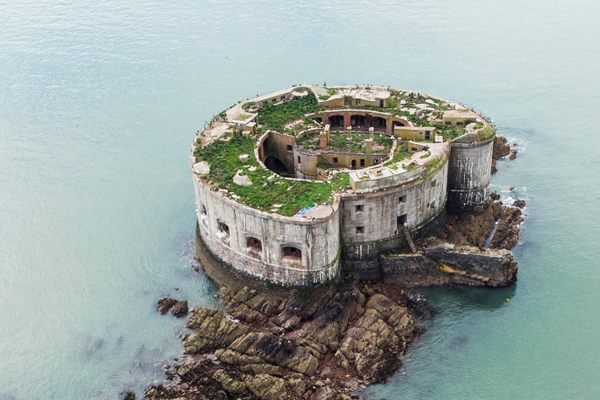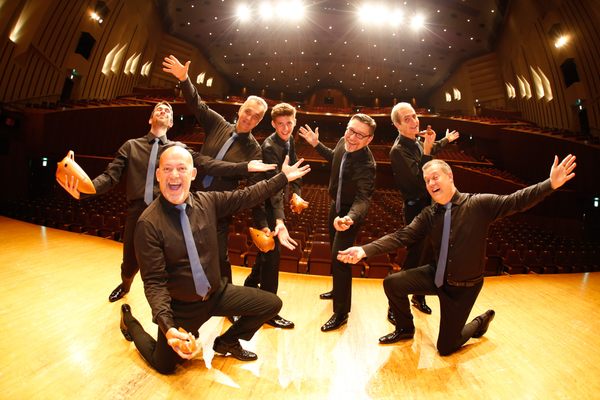
The Italian Bells That Survived Nazis, Fires, and Even the Medieval Ages
One family has been making bells for over 1,000 years—and now wants to send them to the Moon.
Hands aren’t just for typing and texting, but for creating,” says Pasquale Marinelli, a bell artisan in Italy. Pasquale and his brother Armando are the 26th generation of a family who has been crafting handmade bells since the middle ages. Pouring scalding-hot liquid metal into carefully designed molds, the two sweat over glowing embers, working with 10 centuries worth of knowledge in order to spread a medieval chime around the world.
Naturally, such historical work is done in an ancient town called Agnone. Located in Italy’s isolated and rugged southern region of Molise, the quiet stone village lies squarely in a mountainous valley, where green hills roll into each other like waves and hay barrels freckle the land like drops of gold. It’s here, teetering at the top of a rocky outcrop, where you’ll find the two brothers working in the Pontifical Marinelli Bell Foundry, which, appropriately, is the oldest family-run business in Italy and among the oldest in the world.
The Marinellis have been handcrafting bronze bells since at least the 11th century, although archaeological findings at nearby Benedictine monasteries suggest the Marinellis’ craft could date as far back as the 9th century.

“The same techniques and models, everything from A to Z, have been the same for the last 1,000 years,” notes Armando. “Deviating from these methods that have been passed down throughout the generations means shutting the door on 1,000 years of history… We have been given this history, and it’s our responsibility to pass it down.”
The family is unable to find an exact date for the genesis of their business, but they’ve settled sometime around the year 1,000 C.E. with their ancestor Nicodemo Marinelli, for whom they have historical documents. This “original” Marinelli is documented to have been crafting bells in an era when the sonorous instrument had a greater, even primary role in society. “Bells were the first mass media. They heralded the salient moments of the day: to call people to work, for lunch, to return home from work. They were a way of telling time, of warning people,” notes Pasquale.
For almost its entire history, the foundry and its artisans were mobile, moving around to forge bells wherever there was demand. “We were like nomads,” explains Armando, “living away from home for months alongside the tratturi, which were like the highways of antiquity. They were fundamental for our people and allowed us to move around the country.”
Armando instituted the only real change in the family’s long and unmovable history. When he took over in 1981 after the sudden death of his father Ettore, the foundry’s artist, he decided that bells would only be forged within the foundry’s walls. Emerging technologies, such as the ability to ship products across large distances with ease, removed the need to travel.

The foundry was granted a pontifical patent in 1924 by Pope Pius XI. But as an ancient business, the foundry has also experienced its share of hardships. During World War II, Nazi troops seized many of the family’s historic bells and melted them down to create cannonballs. The brothers’ grandfather managed to bury some of the business’ most important bells underground, which were eventually recovered after the war, although Armando suspects there still may be a handful forgotten beneath the town’s earth.
Then, in 1950, a fire tore through the foundry, burning it to the ground and destroying many of its centuries-old historical documents. The family was forced to relocate to a 19th-century granary on what was then the edge of town, where they remain today. Here, the sun splashes through the building’s small, high windows to create defined columns of slanted light that illuminate the foundry in a Caravaggio-esque game of chiaroscuro.

Despite centuries of change that have wrought innumerable epidemics, wars, and global connection, the Marinellis have been quietly forging their bells, adapting to the world’s shifting tides while sticking to their constants. Though the location has changed, one can still smell the clay and wax permeating the air within the current foundry and hear the sound of hammers beating against new bells, creating an echoing symphony.
A Marinelli bell is made with three cups stacked within each other—think of them as Russian nesting dolls. The first cup, called the “soul,” is the internal part of the bell and is created by laying brick fragments upon each other and wrapping them together with iron string. This is slathered in a thick layer of clay, then wax, and then even more clay to create the second cup, named the “false bell,” which will eventually be destroyed to make way for the bronze product. Smoldering coals are poured inside these two structures to bake the clay and melt the wax from the inside out.

Hand-drawn wax molds are then cast onto the exterior of the false bell. “This is a very important step, because once its realised in bronze, it’ll live on for centuries in a church or a community,” explains Armando. While almost everyone in the family partakes in the decoration process, this work falls primarily on Ettore Marinelli, Armando’s 31-year-old son and part of the 27th generation of artisans. Also a talented bronze sculptor, he works mainly in the artist’s hall, a room where thousands of zinc matrices of letters, numbers, and designs drip from the walls in various shapes and sizes like silver ivy. “I was practically born in the foundry. I was already molding clay at the age of three,” says Ettore.
The soul and decorated false bell are then covered in more clay to create the third and final cup, called the “mantle.” Once dry, the mantle, with the wax designs embossed into it, is lifted and the fasle bell is destroyed by hand with a hammer. A bronze alloy, spiced with a smattering of tin, is heated to 1,200 degrees Celsius (roughly 2,192 Fahrenheit) and poured into the bell mold, now consisting only of the mantle and the soul, while a priest blesses the process with a sprinkling of holy water. When the alloy hardens, the mantle is broken apart with a hammer to release the bronze bell, which is then polished until it shines. “It’s a job that genuinely does not bore me,” says Pasquale. “From the smallest bell that is placed on a desk to a large bell like the one for the 2000 Jubilee, they’re all important, and I’m proud of them all.”
The 2000 Jubilee bell is an impressive one, which the Molise region commissioned as a gift to Pope John Paul II. Now housed in the Vatican Gardens in Rome, it weighs a staggering 11,000 pounds, has a circumference of 20 feet, and a height of eight feet—and cost just over €21 million to create. “Aside from its size and iconography that tells the story of this Jubilee, this bell is a great source of pride because it tells the story of Molise, Agnone, and the Marinelli family,” says Armando.
The foundry primarily makes church bells, which can easily fetch hundreds of thousands of euros, depending on their size and the level of artistry. They also make personal and ceremonial bells on request, such as a recent pocket-sized one celebrating the 152-year anniversary of Italy’s unification that was gifted to Japan’s Prime Minister Fumio Kishida during the G7 summit held in the country in May 2023.

Large and small, Marinelli bells can be found in almost every corner of the world, including Romania, India, Hong Kong, the Democratic Republic of the Congo, Chile, and Easter Island, just to name a few. Despite the town’s relatively isolated and overlooked location within Italy, Marinelli bells have ensured that a piece of Agnone is sprinkled across the world map, often in communities and countries that the family’s medieval ancestors had no idea even existed.
If their expansion continues the way it has, the Marinellis are interested in further frontiers. Should the stars align, the next big “achievement” for a Marinelli bell would be a place very few humans have ever set foot: the moon. “Why not?” says Armando, who’s looking for a receptive ear to make the wish come true. “It’s only a matter of bureaucracy and a bit of luck. At the right time, it can happen.”
The biggest threat currently facing the foundry is businesses that have standardized and are able to create bells within short time frames. Because the Marinellis preserve the ancient ways, which on average requires at least four months to make a bell, the foundry produces some 40 bells a year. They are facing intense competition from foundries that have modernized their production methods. “Our Achilles heel is our speed and ability to produce bells quickly,” explains Armando.

The Marinellis are tackling this problem by focusing on building intimate relationships with clients who truly understand the value of artisanal work. And although the foundry primarily relies on bell commissions, it has diversified its source of income by creating a museum and offering guided tours. While the family has always welcomed curious visitors over the centuries, it wasn’t until 2000 that a fully fledged museum dedicated to the foundry’s history opened. Within the museum, you’ll find one of the family’s most precious bells, which dates back to the year 1,000 C.E. Today, the museum charges €9 (roughly $10) for one-hour tours and welcomes some 40,000 visitors a year. “This may just be an average day for the Vatican Museums, but for us it’s a lot,” jokes Armando.
While the 26th and 27th generations of Marinellis are secure, Ettore can’t help but wonder if the successive generations will be willing to take on the weight of the family’s 1,000-year-old legacy. “Being born into a historical family is very demanding. Continuing an ancient profession is a choice that must be made with heart, for your entire life,” he says. “It does not allow for retirement or holidays or vacations. It’s a dedicated life that involves great sacrifices, but also provides unique and sometimes unexpected gratifications.”
Although threats loom over the foundry’s existence and the future is always hidden behind a gauzy veil, Pasquale believes that as long as value continues to be placed in products handmade with care, his family’s business will thrive as it has for the last 10 centuries. “To be an artisan is a hard life, it’s a life of sacrifice,” says Pasquale. “But, it’s also beautiful and full of satisfaction. [The foundry] is my beating heart. To synthesize this whole world into [three] words: It’s my essence.”














Follow us on Twitter to get the latest on the world's hidden wonders.
Like us on Facebook to get the latest on the world's hidden wonders.
Follow us on Twitter Like us on Facebook